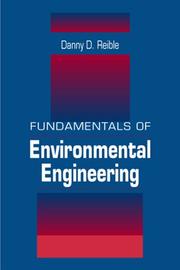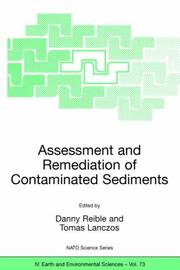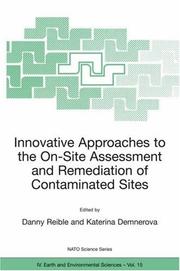| Listing 1 - 6 of 6 |
Sort by
|
Book
ISBN: 146146725X 129985771X 1461467268 Year: 2013 Publisher: New York : Springer,
Abstract | Keywords | Export | Availability | Bookmark
 Loading...
Loading...Choose an application
- Reference Manager
- EndNote
- RefWorks (Direct export to RefWorks)
The purpose of this volume, Processes, Assessment and Remediation of Contaminated Sediment, is to help engineers and scientists better understand contaminated sediment sites and identify and design remedial approaches that are more efficient and effective. Contaminated sediment management is a difficult and costly exercise that is rarely addressed with easily identified and implemented remedies. It is hoped that this book can help identify and implement management approaches that provide an optimal, if not entirely satisfactory, solution to sediment contaminant problems. Topics addressed in this volume include: · An introduction to contaminated sediment management that summarizes the tradeoffs between natural attenuation, containment and active removal (Chapter 1). · A series of chapters describing key sediment processes that separate sediments from contaminated soil sites and make understanding sediment processes difficult: An introduction to the processes that are uniquely associated with contaminated sediment sites including sediment resuspension, groundwater upwelling, hyporheic exchange and bioturbation (Chapter 2). The current understanding of sediment erosion and transport and how these processes are modeled (Chapter 3). A description of the physical and biological processes operative at the sediment-water interface (Chapter 4). · A series of chapters describing sediment risk assessment approaches including: How to design risk assessment programs to support risk management decisions (Chapter 5). The biological effects that usually define the risks that contaminants in sediments represent and the biological assays used to assess those risks (Chapter 6). Assessing bioavailability via chemical measurements, primarily through the use of porewater concentration measurements (Chapter 7). · A series of chapters describing sediment risk management, i.e., remedial approaches and their design, including: Processes describing how to develop and implement risk management efforts (Chapter 8). Each of the key approaches to managing contaminated sediments; monitored natural recovery (Chapter 9), intrinsic biotransformation and biodegradation (Chapter 10), in situ treatment via carbon amendments (Chapter 11), in situ containment via capping with either inert material or with active amendments (Chapter 12) and dredging and excavation (Chapter 13). The design and implementation of a monitoring program to evaluate remedy performance (Chapter 14). Each chapter in this volume has been thoroughly reviewed for technical content by one or more experts in each of the subject areas covered. The editors and chapter authors have produced a well-written and up-to-date treatise that we hope will be a useful reference for those making decisions on the assessment and remediation of contaminated sediments and for those involved in research and development of advanced technology for the assessment and remediation of sediments.
Soil remediation. --- Sediments (Geology) --- Cleanup of contaminated soil --- Remediation of contaminated soil --- Soil cleanup --- Soil contamination remediation --- Hazardous waste site remediation -- Handbooks, manuals, etc. --- Contaminated sediments --- Environment. --- Environmental management. --- Soil science. --- Soil conservation. --- Environmental engineering. --- Biotechnology. --- Environmental Engineering/Biotechnology. --- Environmental Management. --- Soil Science & Conservation. --- Geology --- Physical geography --- Sedimentary rocks --- Sedimentation and deposition --- Marine sediments --- Slackwater deposits --- Soil protection --- Soil pollution --- Conservation of soil --- Erosion control, Soil --- Soil erosion --- Soil erosion control --- Soils --- Agricultural conservation --- Soil management --- Environmental stewardship --- Stewardship, Environmental --- Environmental sciences --- Management --- Chemical engineering --- Genetic engineering --- Control --- Prevention --- Conservation --- Pedology (Soil science) --- Agriculture --- Earth sciences --- Environmental control --- Environmental effects --- Environmental stresses --- Engineering --- Environmental health --- Environmental protection --- Pollution --- Sustainable engineering

ISBN: 3540647465 1566700477 9783540647461 9781566700474 9780367400279 9780203755303 9781351446587 Year: 1999 Publisher: Heidelberg : Boca Raton : Springer ; Lewis Publishers,
Abstract | Keywords | Export | Availability | Bookmark
 Loading...
Loading...Choose an application
- Reference Manager
- EndNote
- RefWorks (Direct export to RefWorks)
The field of environmental engineering is rapidly emerging into a mainstream engineering discipline. For a long time, environmental engineering has suffered from the lack of a well-defined identity. At times, the problems faced by environmental engineers require knowledge in many engineering fields, including chemical, civil, sanitary, and mechanical engineering. Increased demand for undergraduate training in environmental engineering has led to growth in the number of undergraduate programs offered. Fundamentals of Environmental Engineering provides an introductory approach that focuses on the basics of this growing field.This informative reference provides an introduction to environmental pollutants, basic engineering principles, dimensional analysis, physical chemistry, mass, and energy and component balances. It also explains the applications of these ideas to the understanding of key problems in air, water, and soil pollution.
Environmental control --- Environmental effects --- Environmental management --- Environmental stresses --- Environnement--Gestion --- Gestion de l'environnement --- Milieubeheer --- Catastrophe naturelle --- Lutte antipollution --- pollution control --- Environmental engineering. --- Pollution --- Natural disasters --- Environmental impact --- surveys --- Measurement --- engineering --- Models --- design --- Technique de l'environnement. --- Environmental engineering --- Technique de l'environnement --- Study and teaching (Higher) --- Etude et enseignement (supérieur) --- Environnement --- Recyclage --- Étude et enseignement (supérieur) --- Étude et enseignement (supérieur)
Digital
ISBN: 9781402049590 Year: 2006 Publisher: Dordrecht Springer
Abstract | Keywords | Export | Availability | Bookmark
 Loading...
Loading...Choose an application
- Reference Manager
- EndNote
- RefWorks (Direct export to RefWorks)
Water supply. Water treatment. Water pollution --- Environmental protection. Environmental technology --- Biotechnology --- waterverontreiniging --- biotechnologie --- milieubeleid --- milieuzorg --- milieutechnologie --- milieubeheer --- milieuanalyse
Digital
ISBN: 9781461467267 Year: 2014 Publisher: New York, NY Springer
Abstract | Keywords | Export | Availability | Bookmark
 Loading...
Loading...Choose an application
- Reference Manager
- EndNote
- RefWorks (Direct export to RefWorks)
The purpose of this volume, Processes, Assessment and Remediation of Contaminated Sediment, is to help engineers and scientists better understand contaminated sediment sites and identify and design remedial approaches that are more efficient and effective. Contaminated sediment management is a difficult and costly exercise that is rarely addressed with easily identified and implemented remedies. It is hoped that this book can help identify and implement management approaches that provide an optimal, if not entirely satisfactory, solution to sediment contaminant problems. Topics addressed in this volume include: · An introduction to contaminated sediment management that summarizes the tradeoffs between natural attenuation, containment and active removal (Chapter 1). · A series of chapters describing key sediment processes that separate sediments from contaminated soil sites and make understanding sediment processes difficult: An introduction to the processes that are uniquely associated with contaminated sediment sites including sediment resuspension, groundwater upwelling, hyporheic exchange and bioturbation (Chapter 2). The current understanding of sediment erosion and transport and how these processes are modeled (Chapter 3). A description of the physical and biological processes operative at the sediment-water interface (Chapter 4). · A series of chapters describing sediment risk assessment approaches including: How to design risk assessment programs to support risk management decisions (Chapter 5). The biological effects that usually define the risks that contaminants in sediments represent and the biological assays used to assess those risks (Chapter 6). Assessing bioavailability via chemical measurements, primarily through the use of porewater concentration measurements (Chapter 7). · A series of chapters describing sediment risk management, i.e., remedial approaches and their design, including: Processes describing how to develop and implement risk management efforts (Chapter 8). Each of the key approaches to managing contaminated sediments; monitored natural recovery (Chapter 9), intrinsic biotransformation and biodegradation (Chapter 10), in situ treatment via carbon amendments (Chapter 11), in situ containment via capping with either inert material or with active amendments (Chapter 12) and dredging and excavation (Chapter 13). The design and implementation of a monitoring program to evaluate remedy performance (Chapter 14). Each chapter in this volume has been thoroughly reviewed for technical content by one or more experts in each of the subject areas covered. The editors and chapter authors have produced a well-written and up-to-date treatise that we hope will be a useful reference for those making decisions on the assessment and remediation of contaminated sediments and for those involved in research and development of advanced technology for the assessment and remediation of sediments.
Soil pollution. Soil purification --- Environmental protection. Environmental technology --- Pedology --- Biotechnology --- bodemkunde --- milieukunde --- bodembescherming --- milieu --- bodemverontreiniging --- biotechnologie --- milieubeleid --- grondwater --- milieutechnologie

ISBN: 9781402049590 1402049579 9781402049576 1402049587 9786610745432 1280745436 1402049595 Year: 2006 Volume: v. 73 Publisher: Dordrecht Springer
Abstract | Keywords | Export | Availability | Bookmark
 Loading...
Loading...Choose an application
- Reference Manager
- EndNote
- RefWorks (Direct export to RefWorks)
Contaminated sediments pose some of the most difficult site remediation issues. Contaminated sediments typically reside in spatially variable and dynamic systems subject to seasonal flow variations and episodic storm events. The volume of sediments that must be managed at particular sites often exceeds one million cubic meters, dwarfing many contaminated soil sites. These sediments are also associated with equally daunting volumes of water and efforts to remove the contamination typically entrains even more water. The environmental security of both NATO and partner countries is at risk due to the pervasive nature of sediment contamination of rivers, lakes and harbors. A NATO Advanced Research Workshop was convened in Bratislava in May 2005 to discuss current approaches to managing contaminated sediments and to identify research necessary to overcome outstanding problems. In this text, drawn from presentations and discussion of that workshop, current approaches to the assessment and remediation of contaminated sediments will be discussed with the emphasis on in-situ management. Physical, chemical and biological approaches for the assessment and remediation of sediments are all addressed. Developing regulatory and strategic approaches are highlighted with a special emphasis on the potential for biological remediation for the management of contaminated sediments.
milieutechnologie --- milieuanalyse --- biotechnologie --- milieubeheer --- Water supply. Water treatment. Water pollution --- milieubeleid --- Biotechnology --- waterverontreiniging --- milieuzorg --- Environmental protection. Environmental technology --- Contaminated sediments --- Water --- Sédiments contaminés --- Eau --- Congresses --- Pollution --- Congresses. --- Congrès --- EPUB-LIV-FT LIVECOLO LIVTERRE SPRINGER-B --- Environmental management. --- Environmental toxicology. --- Environmental pollution. --- Biotechnology. --- Environmental Management. --- Ecotoxicology. --- Waste Water Technology / Water Pollution Control / Water Management / Aquatic Pollution. --- Environmental Engineering/Biotechnology. --- Chemical engineering --- Genetic engineering --- Chemical pollution --- Chemicals --- Contamination of environment --- Environmental pollution --- Contamination (Technology) --- Asbestos abatement --- Bioremediation --- Environmental engineering --- Environmental quality --- Factory and trade waste --- Hazardous waste site remediation --- Hazardous wastes --- In situ remediation --- Lead abatement --- Pollutants --- Refuse and refuse disposal --- Ecotoxicology --- Environmental health --- Toxicology --- Environmental stewardship --- Stewardship, Environmental --- Environmental sciences --- Management --- Environmental aspects --- Water pollution. --- Environmental engineering. --- Environmental control --- Environmental effects --- Environmental stresses --- Engineering --- Environmental protection --- Sustainable engineering --- Aquatic pollution --- Fresh water --- Fresh water pollution --- Freshwater pollution --- Inland water pollution --- Lake pollution --- Lakes --- Reservoirs --- River pollution --- Rivers --- Stream pollution --- Water contamination --- Water pollutants --- Water pollution --- Waste disposal in rivers, lakes, etc.

ISBN: 1402009569 Year: 2002 Publisher: Dordrecht ; Boston ; London Brussels Kluwer Academic Publishers NATO Scientific Affairs Division
Abstract | Keywords | Export | Availability | Bookmark
 Loading...
Loading...Choose an application
- Reference Manager
- EndNote
- RefWorks (Direct export to RefWorks)
| Listing 1 - 6 of 6 |
Sort by
|

 Search
Search Feedback
Feedback About UniCat
About UniCat  Help
Help News
News